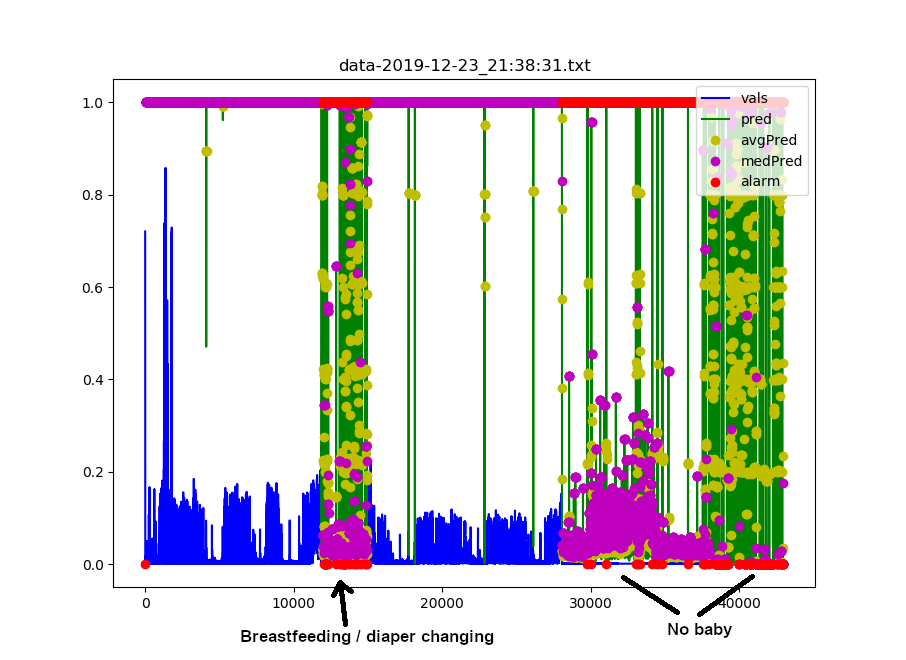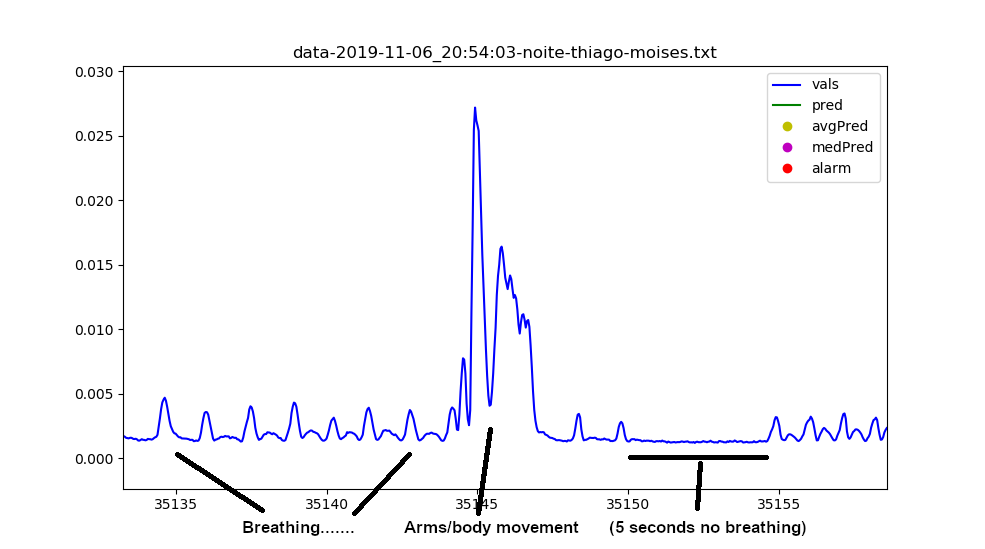Scripts for using Eulerian Video Magnification and neural networks as a baby breathing monitor.
Disclaimer: this is a functional set of scripts to implement a baby breathing monitor using IP camera and Linux computer, however it is not intended for end-users. Setting up the whole thing requires some programming skills and possibly retraining the neural network model with your data. I'm just documenting what I've hacked together to use with my newborn baby - I'm not providing support.
- Video from IP camera is streamed using RTSP protocol
- ffmpeg converts H264 RTSP streamed video to a v4l2 loopback device
- The forked branch of Realtime-Video-Magnification project performs realtime motion video magnification and outputs a "motion scalar" to stdout
- Motion data is piped into
pipeInMagPredictAlarm.pyscript which runs a previously trained Keras model to predict either 1.0 (baby is breathing) or 0.0 (no baby / no breathing) - In case of a long sequence of "no breathing" of ~30 seconds the alarm sounds (currently mplayer playing a sound, may be changed in
alarm-start.sh) - Alarm may be turned on/off from smartphone by acessing a simple web page (quite useful if computer is far away from the sleeping room)
- Set the IP camera for maximum bitrate/quality as possible since compression artifacts may cause false movement detection. I also use GOP size (intra-frame period) to 1. Alternatively one may try using MJPEG instead of MPEG4/H264 etc (I couldn't figure out how to get MJPEG from my camera).
- Load kernel module:
sudo modprobe v4l2loopback - ffmpeg command:
ffmpeg -i rtsp://user:password@192.168.1.10:8554/profile0/media.smp -f v4l2 /dev/video0(The actual URL is camera specific)
The model is trained using treinaRede.py script. This script should be run with a "dataset params" file, which first line defines the global parameters:
inputLen (in frames),batchSize,modelNum
And further text lines will add previously acquired data for training of each tag:
tag(0 or 1),numRandomSlicesForTraining,dataFile
- Current model uses inputLen=125 (5 seconds of 25 fps) and modelNum=2 (3 levels of "relu" with 0.2 dropout factor and sigmoid activation).
- Model was trained using a single data value per frame (the "motion" scalar which is the sum of motion of all pixels). Since lighting conditions may affect the general noise level of the image (compression artifacts and stuff) the Realtime-Video-Magnification branch now outputs 2 values per line: overall motion and the standard deviation of pixels' motion. Scripts have not yet been updated to make use of this new data.
- If camera or lightning conditions change the model may need to be retrained to fix false positive/negatives. I have found useful to save data of every night and eventually retrain the model to fix the misdetections.
Every night I use the following command:
./Realtime-Video-Magnification/src/rvm | python3 pipeInMagPredictAlarm.py --outputDate --alarm
This will execute RVM program (I still need to go through GUI menus to open camera and select Haar Wavelet magnification) and pipe motion data into script. The script will execute the previously trained model, creating a backup of the motion data name as current date and time and call the external alarm if required.
usage: pipeInMagPredictAlarm.py [-h] [--input INPUT] [--output OUTPUT]
[--outputDate] [--plot] [--alarm]
[--clipPlotVals]
Whole night baby's movement and breathing data. The blue line (vals) is the acquired data which is actually fed into the neural network model for prediction. The green line (pred) is the output of the model ranging from 1.0 (breathing or moving) to 0.0 (no movement / no baby). avgPred and medPred are smoothed versions of predicted pred data. Red dots (alarm) show whenever the alarms starts (1) or stops (0).
Detail of a newborn's irregular breathing pattern. In this case the baby stopped breathing for about 5 seconds. This is perfectly normal (literature says that up to 10 seconds of no breathing is commonly seen in newborns).

